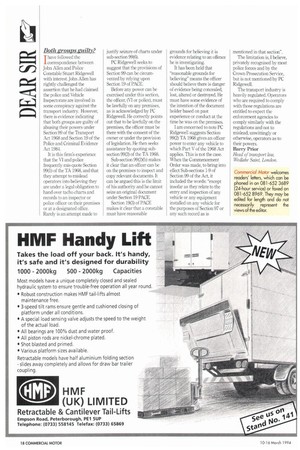Both groups guilty?
Page 20

If you've noticed an error in this article please click here to report it so we can fix it.
T have followed the lcorrespondence between John Allen and Police Constable Stuart Ridgewell with interest. John Allen has rightly challenged the assertion that he had claimed the police and Vehicle Inspectorate are involved in some conspiracy against the transport industry. However, there is evidence indicating that both groups are guilty of abusing their powers under Section 99 of the Transport Act 1968 and Section 19 of the Police and Criminal Evidence Act 1984,
It is this firm's experience that the VI and police frequently mis-quote Section 99(1) of the TA 1968, and that they attempt to mislead operators into believing they are under a legal obligation to hand over tacho charts and records to an inspector or police officer on their premises or at a designated office. Rarely is an attempt made to justify seizure of charts under sub-section 99(6).
PC Ridgewell seeks to suggest that the provisions of Section 99 can be circum. vented by relying upon Section 19 of PACE.
Before any power can be exercised under this section, the officer, (VI or police), must be lawfully on any premises, as is acknowledged by PC Ridgewell. He correctly points out that to be lawfully on the premises, the officer must be there with the consent of the owner or under the provision of legislation. He then seeks assistance by quoting subsection 99(2) of the TA 1968.
Sub-section 99(2)(b) makes it clear that an officer can be on the premises to inspect and copy relevant documents. It can be argued this is the limit of his authority and he cannot seize an original document under Section 19 PACE.
Section 19(3) of PACE makes it clear that a constable must have reasonable grounds for believing it is evidence relating to an offence he is investigating.
It has been held that "reasonable grounds for believing" means the officer should believe there is danger of evidence being concealed, lost, altered or destroyed. He must have some evidence of the intention of the document holder based on past experience or conduct at the time he was on the premises.
I am concerned to note PC Ridgewell suggests Section 99(2) TA 1968 gives an officer power to enter any vehicle to which Part V of the 1968 Act applies. This is not the case. When the Commencement Order was made, to bring into effect Sub-sections 1-9 of Section 99 of the Act, it included the words: "except insofar as they relate to the entry and inspection of any vehicle or any equipment installed on any vehicle for the purposes of Section 97 or any such record as is mentioned in that section", The limitation is, I believe, privately recognised by most police forces and by the Crown Prosecution Service, but is not mentioned by PC Ridgewell.
The transport industry is heavily regulated. Operators who are required to comply with those regulations are entitled to expect the enforcement agencies to comply similarly with the regulations and not to mislead, unwittingly or otherwise, operators as to their powers.
Barry Prior Head of IransPort law, Wed 1w Saint, London.
Commercial Motor welcomes readers' letters, which can be phoned in on 081-652 3689 (24-hour service) or faxed on 081-652 8969. They may be edited for length and do not necessarily represent the views of the editor.




















































































